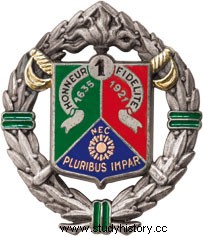
The Royal Stranger
The 1st Foreign Cavalry Regiment (1er REC) has the particularity of being the only Foreign Legion regiment specializing in armored combat. It is the cavalry regiments of the 6th Light Armored Brigade.
Coming from Mers el-Kébir, he was stationed at Quartier Labouche in Orange from 1967 to 2014.
From July 2014, the 1er REC moved to Camp de Carpiagne to replace the 4th regiment of dragoons, which had been dissolved.
From its creation in 1921, it served alternately on horseback in Syria and Morocco, then on White-Laffy armored cars. During the French campaign in 1940, it was equipped with sidecars and finally American light tanks at the Liberation of France.
The 1er REC also took part in the Indochina War on board amphibious vehicles, then on board EBRs during the Algerian War.
Creation and different denominations
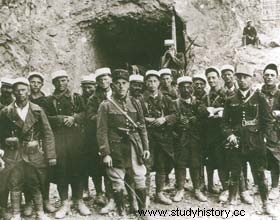
The 1st foreign cavalry regiment was created in 1921 in Sousse (current Tunisia) from elements of the 2nd foreign infantry regiment. Second Lieutenant Antraygues Marcel was also the first officer of the legion appointed to serve there in the 1st cavalry squadron formed in October 1920 in Saïda (Algeria).
At that time the Foreign Legion was only made up of infantry regiments and the idea of creating another specialty was far from unanimous. Nevertheless, the Legion counted among its personnel many Russians from the White Armies defeated by the Bolsheviks. Drawing on the experience of the Tsarist light cavalry, they enabled the Legion to quickly establish itself in the cavalry.
Since then, the "Royal foreigner" has constantly demonstrated the adaptability of the Legion coupled with the flexibility of the riders.
From creation to World War II
From 1921, he was engaged simultaneously in Syria and Morocco. He covers himself with glory in these two theaters of operations, notably in the Levant during the battles of Messifre and Rachaya, where the Landriaux squadron commands the admiration of all and obtains the fourragère of the TOE (outside theaters of operations).
From 1927 to 1934, the REC concentrated its efforts on Morocco, destroying the rebel bands during bitter engagements and then ensuring the security of the Saharan tracks in full development.
World War II
In 1940, the 1er REC intervened in France under the name of GRDI 97. Engaged on May 18 on the Somme, it fought there until the armistice. his legionnaires.
In 1943, the regiment was again engaged in Tunisia against the Germans.
In 1944-1945, it became the reconnaissance regiment of the 5DB and took part in the Alsace campaign and the capture of Stuttgart
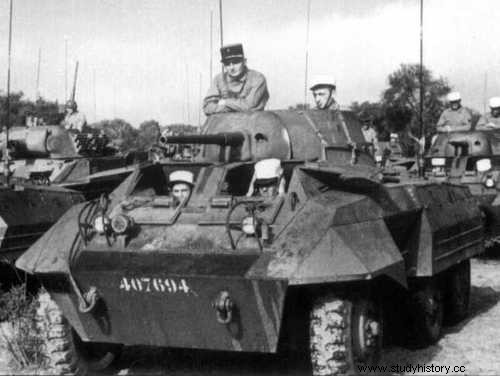
At the end of the war, its standard was enriched with two new palms and the fourragère of the Croix de guerre.
Indochina War
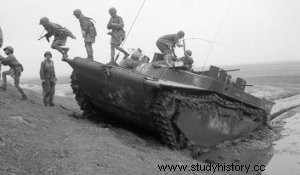
In 1946, the 1erREC embarked for Indochina. Its two squadrons and those of the two autonomous groups which serve under the insignia and standard of the regiment participated for nine years in the hard fighting which took place from Cochinchina to Tonkin.
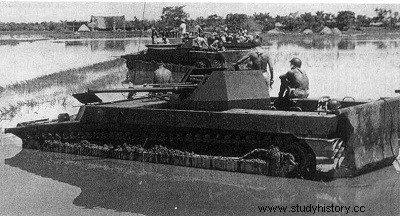
Three new quotes and the fodder from the TOEs enrich the tie of the 'standard. For their part, the two autonomous groups deserved six citations.
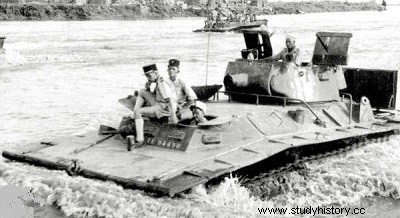
War in Algeria
In 1954, the regiment returned to African soil and intervened in the pacification of Algeria for eight years. After the Évian agreements, it was regrouped on the base of Mers el-Kébir and joined France in 1967.
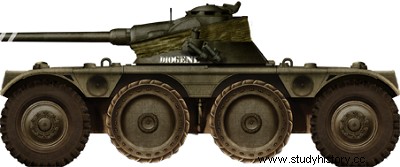
The metropolis and the African years
The regiment was attached to the 14th Infantry Division (14th DI) on January 1, 1976. In 1978 and 1979, it took part in Operation Tacaud in Chad, where it was cited at the order of the army. The squadrons are then engaged several times on short-term missions in the Central African Republic, in Bouar in particular.
In 1983, as part of the 31st Brigade, the 1er REC was engaged in Lebanon, within the Multinational Security Force in Beirut (F.M.S.B.) and then in Chad again.
Kuwait War (1990-1991)
From September 15, 1990, after the invasion of Kuwait by Iraq, the regiment was fully engaged within the Daguet division during Operation Desert Shield and then Desert Storm. On February 23, 1991, the regiment crossed the Iraqi border and, 36 hours later, seized its objective, the air base of As Salman.
The 1er REC then hangs a new palm on its standard.
Cambodia
From December 1992 to June 1993, the regiment returned to the Far East as part of the United Nations Provisional Authority in Cambodia (APRONUC).
From the former Yugoslavia to the Coast of Ivory
A squadron of the regiment was engaged in October 1993 within the United Nations Protection Force (UNPROFOR) in Sarajevo. Since then, one or more squadrons have regularly been engaged in the Balkans.
At the same time, the regiment continues to send its basic units in external operations (Operation Epervier in Chad) or in short-term missions (MCD) of 4 months in Guyana, Mayotte, Djibouti, etc.
In 1997, the regiment, in particular the 2nd squadron, participated in the evacuation of European nationals in the Republic of Congo.
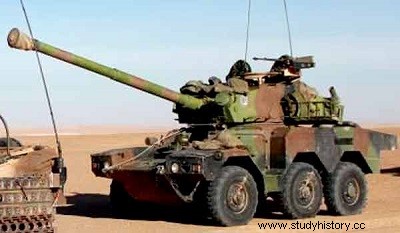
Finally, in 1999, he took part in NATO operations in the Balkans by sending a squadron to Macedonia, then participating in the security force in Kosovo.
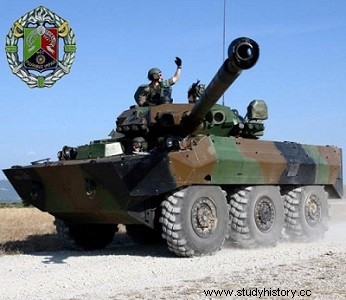
The regiment was engaged in Mali as part of Operation Serval in January 2013.
Traditions
The 1er REC, with its double specificity, makes a point of respecting the traditions of the Legion, as well as those of the cavalry.
Its personnel wear silver rank insignia in the colors of mounted arms and the seven-flame grenade of the Foreign Legion.
Currency
« "Nec pluribus impar" » ("No other equal")
Insignia
In 1936, at the instigation of Captain Robert and on the orders of Lieutenant-Colonel Berger, a badge project was implemented within the regiment. It was that of quartermaster Allnikine of the 2nd squadron which was selected, then sent on May 20, 1936 to Maison Arthus-Bertrand in Paris, which then proposed three models:after consultation with all the squadrons in Tunisia and the Morocco, model number three was chosen. It still serves as a model for the badges produced by Maison Arthus Bertrand. Since then, the badge of the 1er REC has never ceased to be worn without any modification. A first order of 1,000 badges at the price of 3.25 F each was established on August 5, 1936, accompanied by 150 badges of more careful manufacture for the attention of officers and non-commissioned officers.
Standard
It bears, sewn in gold letters in its folds, the following inscriptions
Kuwait 1990-1991 (1990-1991)
Decorations
His tie is decorated:
From the fodder in the colors of the 1914-1918 war cross with an olive in the colors of the 1939-1945 war cross, then from the fodder in the colors of the TOE war cross.
The War Cross 1939-1945 with 3 palms.
The TOE War Cross with 4 palms.
The Military Valor Cross with one palm.
The 4th squadron was also decorated on November 19, 2012 with the Cross of Military Valor with Palm (Afghanistan)
War Cross 39-45
TOE War Cross
Singing
The column
A column of the Foreign Legion
Advances in the bled in Syria,
The head of the column is formed
By the First Foreign Cavalry.
The Druses advance to battle,
Forward, legionnaires to the enemy,
The bravest in battle as always,
It's the First Foreign Cavalry.
A legionnaire falls, hit by a bullet,
Farewell my parents, my friends,
All my faults, I have expiated them,
To the First Cavalry Foreigner.
On his grave stands a simple cross,
On which only these words are inscribed,
He served honest and faithful,
To the First Cavalry Foreigner.
Note:all Legion personnel must sing to attention, the entire chant in the regimental garrison, and the last verse in all cases.List of corps commanders
1921:Colonel Perret
1922:Lieutenant-Colonel Sala
1923:Colonel Maurel
1925:Colonel Sala
1931:Colonel Burnol
1932:Colonel Bonnefous
1935:Colonel Berger
1940:Colonel le Vavasseur
1943:colonel Miquel
1945:squadron leader Lboreux
1945:colonel Robert
1946 :lieutenant-colonel Marion
1948 :lieutenant-colonel Doré
1949 :lieutenant-colonel de Battisti
1951 :lieutenant-colonel Royer
1952:Lieutenant-Colonel Deluc
1953:Lieutenant-Colonel Hardoin
1954:Lieutenant-Colonel Coussaud de Massignac
1956:Squadron Leader Ogier de Baulny
1956:Lieutenant-Colonel Spitzer
1958:Lieutenant-Colonel de Blignères
1960:Lieutenant-Colonel de la Chapelle
1961:Lieutenant-Colonel Barazer de Lannurien
1962:Lieutenant-Colonel de Monplanet
1963:Lieutenant-Colonel de Froissard de Broissia
1965:Lieutenant-Colonel Ansoborlo
1967:Lieutenant-Colonel Bart
1969:Lieutenant-Colonel Caillard d'Aillières
1971:Lieutenant-Colonel Fesneau
1973:Lieutenant-Colonel Lorho
1975:Lieutenant-Colonel Devouges
1977:Lieutenant- colonel Le Corre
1979:lieutenant-colonel Audemard d'Alançon
1981:lieutenant-colonel de la Presle
1983:lieutenant -Colonel Ansart de Lessa n
1985:Colonel Belloir
1987:Colonel Badie
1989:Colonel Ivanoff
1991 :colonel de Kermabon
1993 :colonel Franceschi
1995 :colonel H. Clément-Bollée
1997 :colonel Colas des Francs
1999:Colonel B. Clément-Bollée
2001:Colonel Yakovlev
2003:Colonel de Saint-Chamas
2005:colonel Windeck
2007:colonel Dupont
2009:colonel Jaron
2011:colonel Béchon
2013:Colonel Bouzereau
Personalities who served in the regiment
H.R.H. Henri d'Orléans "Henry VII Prince of France", Count of Paris, Duke of France, from 1965 to 1968
The regiment today
Missions
The 1er REC, as a light cavalry regiment, represents the spearhead of the 'steel glove brigade'.
He is not only able to carry out the missions specific to the armored cavalry, but also missions of research and acquisition of intelligence using the squadron of lighting and investigation. /P>
Organization
The 1st Foreign Cavalry Regiment is divided into 5 squadrons totaling a strength of approximately 800 men.
The command and logistics squadron (ECL), brings together all the deployable services necessary for the command of the regiment in operations (communications, operations office, nurses, transport platoon, maintenance, etc.)
The administration and support squadron (EAS) brings together all the non-deployable services of the regiment (administrative services, barracks, catering, etc.). This squadron was transferred to the support group of the Nîmes-Orange-Laudun Defense Base, to which the regiment is administratively attached
3 combat squadrons (1st, 2nd and 3rd) each composed of 4 combat platoons and a command platoon. Each squadron is equipped with 12 AMX 10 RC type light tanks. Many executives and legionnaires have the dual specialty AMX-10 RC - ERC-90 Sagaie. This dual specialty allows them to serve both equipment in service with the regiment (as during the Gulf War in 1991), and equipment encountered in other theaters (Djibouti, Ivory Coast, etc. .)
Reconnaissance and Intervention Squadron (ERI). This squadron (the 4th), which depends for employment on the general commanding the 6th light armored brigade is composed of 4 platoons of reconnaissance and anti-tank intervention PRIAC on VBL.
The Reserve Squadron (ER). This squadron was created in 2012 and brings together around a hundred operational reservists.
Materials
The regiment uses major armored and cavalry equipment:
AMX-10 RC:six-wheeled amphibious tank equipped with a 105 mm gun, requires a four-man crew (commander, driver, loader and gunner);
VBL:armored vehicle light amphibious allowing the transport of 3 to 4 men under armor, with the possibility of installing armament in the superstructure (12.7 mm machine gun, Milan missile);
VAB:amphibious armored vehicle which is used as a troop transport, medical vehicle or even as a transmission PC.
